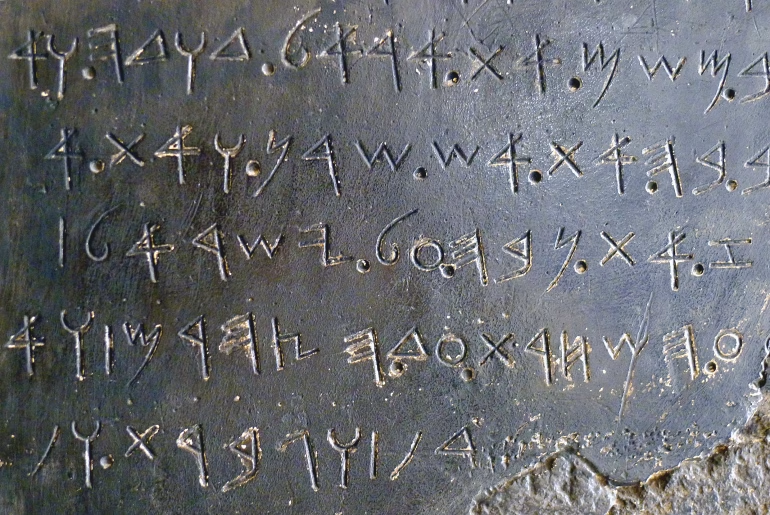The Old Syriac Manuscripts of the Four Gospels
The “Old Syriac” manuscripts of the Four Gospels1 known as the Sinaitic Palimpsest, discovered by Mrs. Agnes Lewis in the Covenant of St. Catherine on Mount Sinai in 1892, unfortunately was forged by the Monks, deliberately, before it was sold to Mrs. Lewis and her companions. They made a hole in the date of the manuscript, thus apparently increasing its age by 900 years. The work actually was finished in 1599 A.D. The English scholars who examined it first, placed its date as of 697 A.D. Then, not being sure, they made a second inspection, and assigned to it a later date, at 778 A.D. Dr. Burkitt (then a young student), at the time of its discovery, thought that the hole in the date was natural, that is, in the skin when dated. He failed to realize that no responsible scribe would date a manuscript near a hole in such a way as to leave the reader in doubt as to the exact date.
The above-mentioned error in date recently was discovered by the writer, after examining several other Four-Gospel manuscripts which were brought to America from the Near East. All the owners of these manuscripts had used the same malpractice. They had made it appear from the mutilated dates that the manuscripts were one thousand years older than they actually were. One of these manuscripts is at the Union Theological Seminary in New York, another is at Harvard, and another is in Syria. “Palimpsest” means double writing, or one writing over the other. The superwriting in Aramaic, on the vellum of the so-called Sinaitic, was the story of martyrology. One of the stories is that of Santa Augenia, believed to be a European Saint never heared of in the East. The book evidently was introduced by the Roman Catholic missionaries after the union of the Chaldeans with the Church of Rome in the sixteenth century. The work underlying the superwriting is that of a student who copied the Gospels for penmanship. No layman or priest in the East would destroy a sacred text of the Four Gospels just to write a history of the Saints. Such an act would be considered sacrilegious. Other palimpsest texts of this nature, including the so-called Curetonian, are of late origin and are not authentic. They were never used by the Christian of the Church of the East.
How To Ascertain An Original ? Aramaic Words Mistranslated
The following samples2 will show how the translators of the New Testament into Greek misunderstood some of the Aramaic words and idioms :
-
raka (raca), “spitting”, in Matthew 5:22, is left untranslated.
oraken hoaw beapohe, “and they spat on his face” (Mark 15:19).
neshtvon, “worthy”, in Matthew 18:19, is rendered sumphonesosin, confusing it with the Aramaic word methawon, “agree” (cf. Matt. 5:25)
khaneptha, “heathen”, in Mark 7:26, is translated into the Greek version, ellenis, “Greeks”. The Aramaic word for “Greeks” is yonaye. The Eastern text reads as “a heathen from Syria.”
Mistakes of Biblical Translations
The following samples3 will show how the translators of the New Testament into Greek misunderstood some of the Aramaic words and idioms.
-
meshtamlena, “will be through”, in Luke 13:32, is rendered teleioumai, “will be perfected.”
esaor, “to work” (spiritual work), in Luke 13:33, is translated pporeuesthai, “to walk.” The Eastern text reads, “But, I must do my work today and tomorrow.”
rokha dekhorhana, “rheumatism”, in Luke 13:11, is rendered pneuma, “spirit.” The Aramaic text reads, “Who was afflicted with rheumatism for eighteen years ; and was bent down and could never straighten herself at all.”
breh, “his son”, in Luke 14:5, is rendered into Greek, whios, “an ass.” The Aramaic text reads, “His son or his ox.”
ammey, “Gentiles”, in John 12:20, is rendered ellenes, “Greeks.”
eteh damshikha, “the Church of Christ”, in Acts 20:28, is changed to ekklesian tou theou, “the Church of God.” It reads as, “The Church of God, which he has purchased with his own blood.” The Eastern text reads, “The Church of Christ which he has purchased with his own blood.” During the apostolic age, Jesus was called “Our Lord, or Christ”. The apostles being Semites, could not have thought of God as having blood.
rashiay, “wicked”, in Romans 5:7, is rendered dikaiou, “just man”. The Aramaic text reads, “Hardly would any man die for the sake of the wicked ; but for the sake of the good, one might be willing to die.” Christ died for the sake of the wicked (Romans 5:6 – 8)
And only God knows best !





1 Comment
It is a misconfusion in Muslims especially that modern day Christians are followers of Jesus Christ(P.B.U.H) but instead they are followers of Paul.